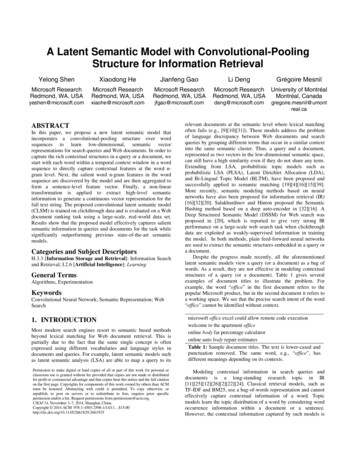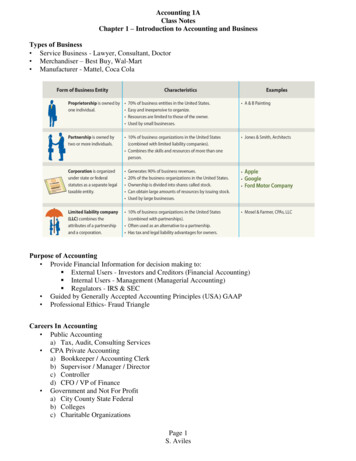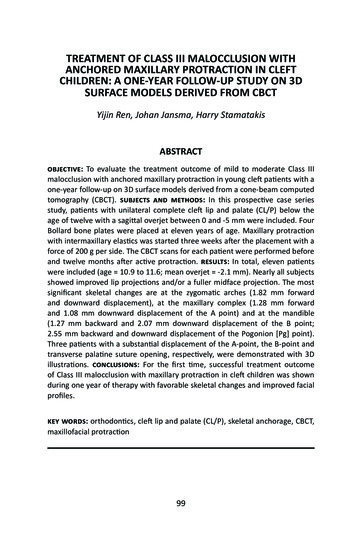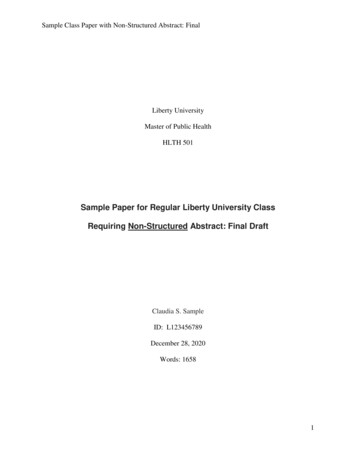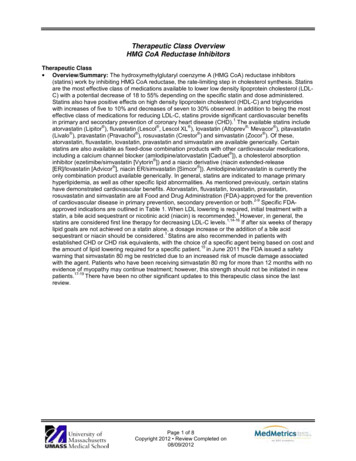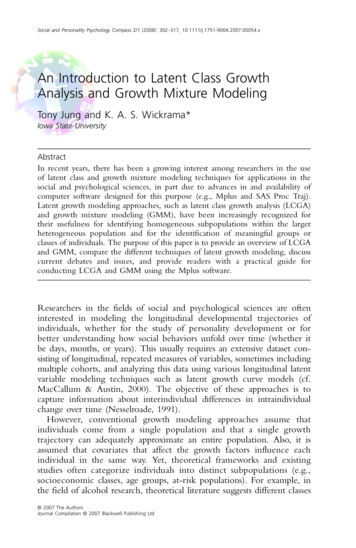
Transcription
Social and Personality Psychology Compass 2/1 (2008): 302–317, 10.1111/j.1751-9004.2007.00054.xAn Introduction to Latent Class GrowthAnalysis and Growth Mixture ModelingTony Jung and K. A. S. Wickrama*Iowa State UniversityAbstractIn recent years, there has been a growing interest among researchers in the useof latent class and growth mixture modeling techniques for applications in thesocial and psychological sciences, in part due to advances in and availability ofcomputer software designed for this purpose (e.g., Mplus and SAS Proc Traj).Latent growth modeling approaches, such as latent class growth analysis (LCGA)and growth mixture modeling (GMM), have been increasingly recognized fortheir usefulness for identifying homogeneous subpopulations within the largerheterogeneous population and for the identification of meaningful groups orclasses of individuals. The purpose of this paper is to provide an overview of LCGAand GMM, compare the different techniques of latent growth modeling, discusscurrent debates and issues, and provide readers with a practical guide forconducting LCGA and GMM using the Mplus software.Researchers in the fields of social and psychological sciences are ofteninterested in modeling the longitudinal developmental trajectories ofindividuals, whether for the study of personality development or forbetter understanding how social behaviors unfold over time (whether itbe days, months, or years). This usually requires an extensive dataset consisting of longitudinal, repeated measures of variables, sometimes includingmultiple cohorts, and analyzing this data using various longitudinal latentvariable modeling techniques such as latent growth curve models (cf.MacCallum & Austin, 2000). The objective of these approaches is tocapture information about interindividual differences in intraindividualchange over time (Nesselroade, 1991).However, conventional growth modeling approaches assume thatindividuals come from a single population and that a single growthtrajectory can adequately approximate an entire population. Also, it isassumed that covariates that affect the growth factors influence eachindividual in the same way. Yet, theoretical frameworks and existingstudies often categorize individuals into distinct subpopulations (e.g.,socioeconomic classes, age groups, at-risk populations). For example, inthe field of alcohol research, theoretical literature suggests different classes 2007 The AuthorsJournal Compilation 2007 Blackwell Publishing Ltd
Latent Trajectory Classes303of alcohol use initiation patterns, e.g., ‘early’ versus ‘late’ onsetters (Hill,White, Chung, Hawkins, & Catalano, 2000). Using growth mixture modeling(GMM) with five different indices of alcohol use (alcohol use disorder,alcohol dependence, alcohol consequences, past year alcohol quantity andfrequency, and heavy drinking), Jackson and Sher (2005) identified fourdistinct classes for each measure. The results of these studies confirmtheoretical contentions that heterogeneity of growth trajectories existwithin the larger population. In addition, these findings suggest thatdescribing an entire population using a single growth trajectory estimateis oversimplifying the complex growth patterns that describe continuityand change among members of different groups. Instead, a latent class orgrowth mixture modeling approach seems to be the most appropriatemethod for fully capturing information about interindividual differencesin intraindividual change taking into account unobserved heterogeneity(different groups) within a larger population.Person-Centered and Variable-Centered AnalysesA useful framework for beginning to understand latent class analysis andgrowth mixture modeling is the distinction between person-centered andvariable-centered approaches (cf. Muthén & Muthén, 2000). Variablecentered approaches such as regression, factor analysis, and structuralequation modeling focus on describing the relationships among variables.The goal is to identify significant predictors of outcomes, and describehow dependent and independent variables are related. Person-centeredapproaches, on the other hand, include methods such as cluster analysis,latent class analysis, and finite mixture modeling. The focus is on therelationships among individuals, and the goal is to classify individuals intodistinct groups or categories based on individual response patterns so thatindividuals within a group are more similar than individuals betweengroups.Growth Mixture ModelingGiven a typical sample of individual growth trajectories (Figure 1, left),conventional growth modeling approaches give a single average growthestimate (bold line), a single estimation of variance of the growth parameters,and assumes a uniform influence of covariates on the variance and growthparameters. However, there may exist a subset of individuals (Figure 1,right) whose growth trajectories are significantly different from the overallestimate. In this example, the figure on the left-hand side represents asample of individual adolescent mental health growth trajectories (SCL-90-Rdepression, anxiety, and somatic symptoms measures), with an averagepositive intercept and slope. The figure on the right-hand side is asubset of the entire sample, representing adolescent mental health growth 2007 The Authors Social and Personality Psychology Compass 2/1 (2008): 302–317, 10.1111/j.1751-9004.2007.00054.xJournal Compilation 2007 Blackwell Publishing Ltd
304 Latent Trajectory ClassesFigure 1(right).Individual trajectories for adolescent mental health (left) and the recovery classtrajectories that are decreasing in poor mental health symptomology, thatis, improving mental health. Individuals in this ‘recovery’ group have ahigher intercept and a negative slope, characteristics of the growthparameters that are clearly different from that of the whole sample.The conventional growth model can be described as a multilevel, randomeffects model (Raudenbush & Bryk, 2002). According to this framework,intercept and slope vary across individuals and this heterogeneity is capturedby random effects (i.e., continuous latent variables). However, as mentionedpreviously, this approach assumes that the growth trajectories of allindividuals can be adequately described using a single estimate of growthparameters (both the mathematical form and the magnitude). Underlyingthis framework is the assumption that all individuals are drawn from asingle population with common parameters. GMM, on the other hand,relaxes this assumption and allows for differences in growth parametersacross unobserved subpopulations. This is accomplished using latent trajectory classes (i.e., categorical latent variables), which allow for differentgroups of individual growth trajectories to vary around different means(with the same or different forms). The results are separate growth modelsfor each latent class, each with its unique estimates of variances andcovariate influences. This modeling flexibility is the basis of the GMMframework (cf. Muthén & Asparaouhov, 2006).Latent class growth analysis (LCGA) is a special type of GMM, wherebythe variance and covariance estimates for the growth factors within eachclass are assumed to be fixed to zero. By this assumption, all individualgrowth trajectories within a class are homogeneous. This framework ofgrowth modeling has been extensively developed by Nagin and colleagues(cf. Nagin & Land, 1993) and is embodied in the SAS procedure ProcTraj (Jones, Nagin, & Roeder, 2001). The benefit of this approach is theidentification of distinct classes prior to conducting GMM. It serves as astarting point for conducting GMM. In terms of computation, it is easyto specify in Mplus and the zero constraints on the variance estimatesallow for faster model convergence (cf. Kreuter & Muthén, 2007). 2007 The Authors Social and Personality Psychology Compass 2/1 (2008): 302–317, 10.1111/j.1751-9004.2007.00054.xJournal Compilation 2007 Blackwell Publishing Ltd
Latent Trajectory Classes305Current Issues and DebateMuch of the current issues and debate surround three main areas: (i) thedetermination of latent trajectory classes; (ii) which model fit index touse; and (iii) the problem of convergence. The first issue is concernedwith the question whether latent classes really exist and if so, how many?For example, Bauer and Curran (2003a, b) cautioned that the existence ofmultiple classes may simply be due to skewed or nonnormally distributeddata.Assuming there are multiple classes, how does one determine howmany there are? Currently, methods for determining the number ofcomponents in a growth mixture model consists of finding the modelwith the smallest Bayesian information criteria (BIC) value and a significant Lo, Mendell, and Rubin (2001) likelihood ratio test (LMR-LRT)statistic. More recently, however, further simulations have demonstratedthat while the BIC performed the best among the information criteriabased indices, the bootstrap likelihood ratio test (BLRT) proved to abetter indicator of classes across all of the models considered. All of thesefit indices are available in Mplus (see Nylund, Asparouhov, & Muthén,2007, for a discussion on fit indices). Analogous to determining thenumber of factors using exploratory factor analysis, the number of classesshould ultimately be determined by a combination of factors in additionto fit indices, including one’s research question, parsimony, theoreticaljustification, and interpretability (cf. Bauer & Curran, 2003b; Muthén,2003; Rindskopf, 2003).A third issue that is often raised is the problem of nonconvergence andlocal solutions (cf. Hipp & Bauer, 2006). Trying to mathematically modela sample distribution that consists of a mixture of many different kindsof subdistributions (i.e., a finite mixture model) is extremely difficult.Such attempts are notorious for convergence issues due to likelihoodestimation problems (e.g., local minima and maxima and singularities).Like other methods such as cluster analysis, latent class analysis, and finitefixture modeling, growth mixture models are also susceptible to localsolutions. The problem of local solutions is where during curve estimationa largest value (maximum) or smallest value (minimum) that a functiontakes is identified for only a given area on that curve, but that is notnecessarily the largest or smallest value for the entire curve (i.e., the globalminimum or maximum). The problem with local solutions in latent classanalysis has long been known (Goodman, 1974). In mixture modeling,parameters are estimated by the method of maximum likelihood and areiterative in nature (e.g., EM algorithm). Ideally, the iteration will result insuccessful convergence on the global maximum solution, that is, theparameter estimates associated with the largest loglikelihood. However,the algorithm cannot distinguish between a global maximum and a localmaximum. As long as it reaches some maximum, the algorithm will 2007 The Authors Social and Personality Psychology Compass 2/1 (2008): 302–317, 10.1111/j.1751-9004.2007.00054.xJournal Compilation 2007 Blackwell Publishing Ltd
306 Latent Trajectory ClassesFigure 2Representation of a growth mixture model with covariates.terminate. Fortunately, the Mplus software incorporates the use of randomstarting values, with sufficient user flexibility, to avoid local solutions inGMM.GMM and LCGA in MplusThis section outlines the basic steps for specifying a simple LCGA andGMM model in Mplus Version 4.1, briefly explains the different usermodifiable options, and highlights specific parts of the output that thebeginning user needs to be aware of. Readers are recommended to referto Chapter 8 in the Mplus User’s Manual available at www.statmodel.comfor a complete treatment of longitudinal mixture modeling. Examplesof input and output for more complex analyses, with more detailedinstructions are available at www.statmodel.com/examples/penn.shtml.The general latent variable growth mixture model can be represented asfollows:The growth mixture model in Figure 2 consists of the followingcomponents: (i) a univariate latent growth curve of observed variable Twith an intercept (I) and slope (S), (ii) a categorical variable for class (C),and (iii) covariates or predictor variables (X). A distal continuous outcomevariable (Y) or a dichotomous outcome variable (U) can be also added tothe model by regressing Y onto C, but is not shown here. The simpleunivariate latent growth curve with latent growth factors, intercept (I)and slope (S), are formed by the observed variables T1, T2, and T3 thatrepresent repeated measures across three time points. A fourth repeatedmeasure (T4) could also be added to the model to estimate a quadraticgrowth factor (Q), but for sake of simplicity only the slope factor is 2007 The Authors Social and Personality Psychology Compass 2/1 (2008): 302–317, 10.1111/j.1751-9004.2007.00054.xJournal Compilation 2007 Blackwell Publishing Ltd
Latent Trajectory Classes307considered here. As an aside, estimating additional growth factors, forexample, a quadratic term, will add computational burden, so it is notunusual to see the variance of the quadratic term and other growth factorsin select classes fixed to zero to aid in convergence during GMM.The categorical latent class variable (C) is related to the covariates (X)by way of multinomial logistical regression. The Mplus multinomialregression assigns each individual fractionally to all classes using theposterior probabilities, obtained through the EM iterations. The first setof fractional assignments is based on the starting values, and they are theniteratively improved on until convergence. In the case of a dichotomouscovariate (e.g., 0 females, 1 males), the coefficient is the increase inthe log-odds of being in the disengaged versus the normative class for aone-unit increase in X, for example, when comparing males to femalesin this example. Hence, a coef
Trying to mathematically model a sample distribution that consists of a mixture of many different kinds of subdistributions (i.e., a finite mixture model) is extremely difficult. Such attempts are notorious for convergence issues due to likelihood estimation problems (e.g., local minima and maxima and singularities). Like other methods such as cluster analysis, latent class analysis, and .
